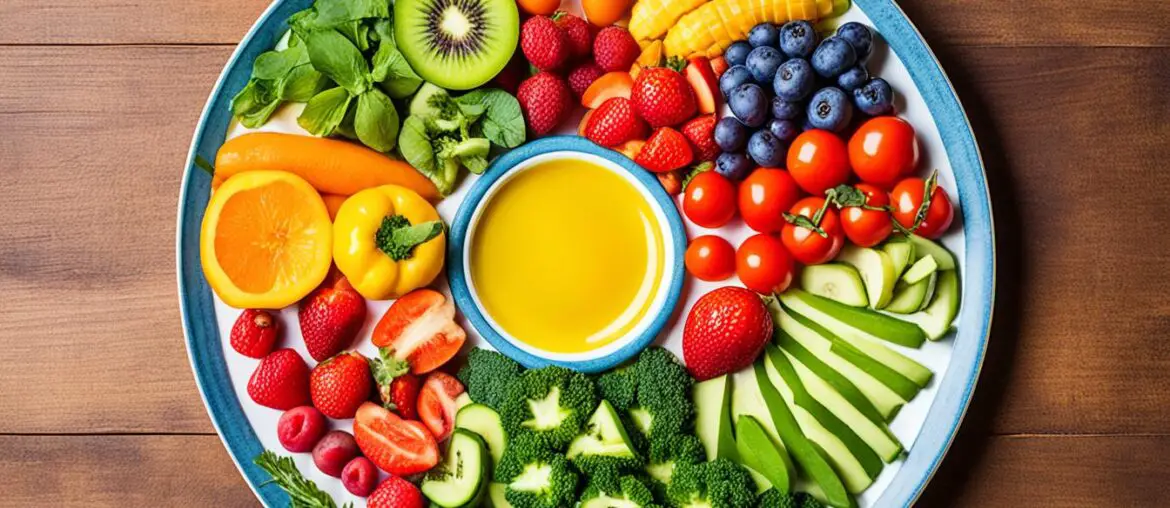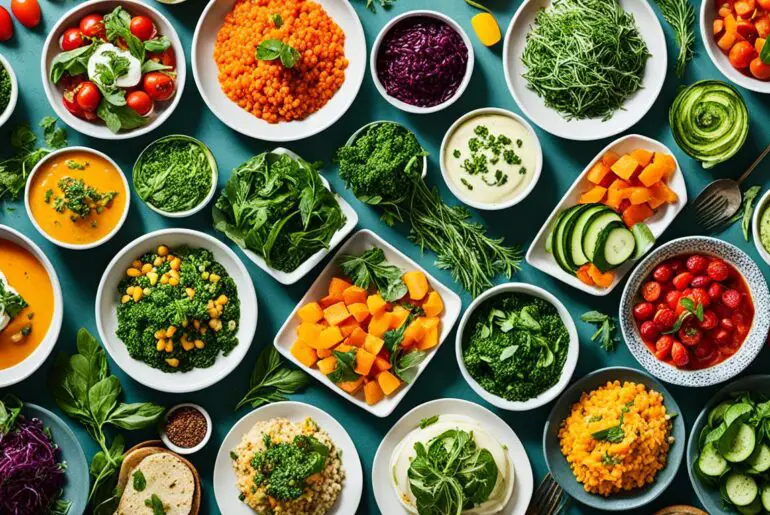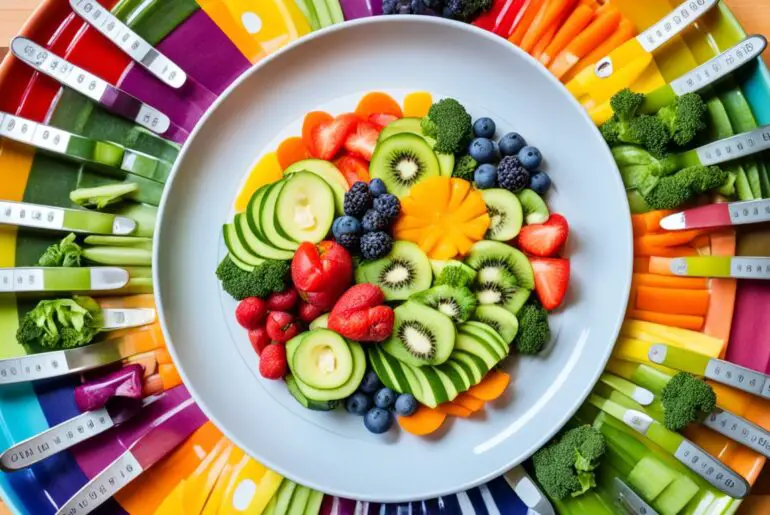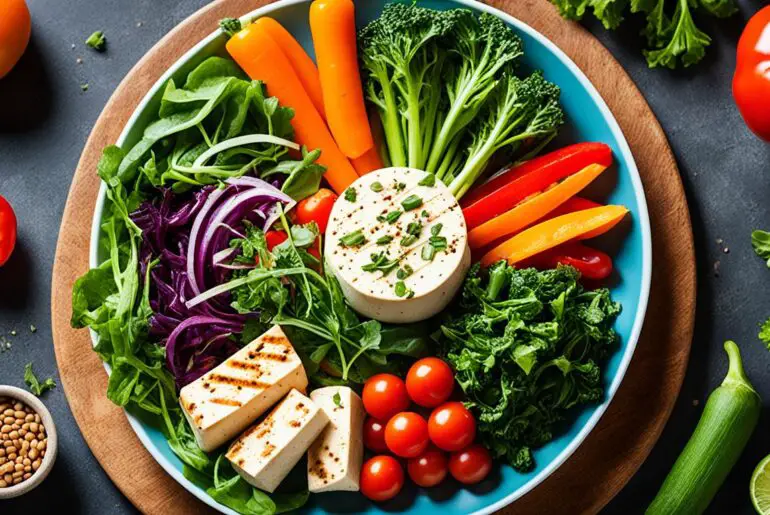Are you a vegetarian looking to shed those extra pounds? If so, you may have heard of the vegetarian HCG diet. But can a vegetarian weight loss program really be effective without the inclusion of animal protein sources? The answer may surprise you.
The vegetarian HCG diet offers a tailored approach to weight loss for individuals following a vegetarian or vegan lifestyle. By combining an ultra-low calorie diet and the use of HCG hormone, this diet has been proven to promote weight loss in both men and women. But how can you maximize your weight loss on the vegetarian HCG diet? Allow me to guide you through the process.
In this article, you will discover the key strategies and tips for maximizing weight loss on the vegetarian HCG diet. From understanding the phases of the diet to incorporating exercise, managing hunger and cravings, and monitoring progress, I will provide you with the knowledge you need to achieve your weight loss goals.
Key Takeaways:
- Discover the effectiveness of the vegetarian HCG diet for weight loss.
- Learn how to navigate the different phases of the diet as a vegetarian.
- Explore the plant-based protein sources suitable for the vegetarian HCG diet.
- Get inspired with delicious vegetarian meal ideas for the HCG diet.
- Understand the importance of exercise and hydration for maximizing weight loss.
Understanding the HCG Diet and its Phases
The HCG diet is a structured weight loss protocol that consists of several phases. Understanding these phases and following a tailored plan is essential for maximizing weight loss results on the HCG diet.
The phases of the HCG diet include:
- Loading Phase: During this initial phase, individuals consume a high-calorie diet to prepare their body for the upcoming fat burn phase.
- Fat Burn Phase: This phase is the main part of the HCG diet, where individuals follow a low-calorie diet and receive HCG hormone injections or take HCG drops. The combination of the HCG hormone and calorie restriction helps burn excess fat.
- Maintenance Phase: After completing the fat burn phase, individuals gradually increase their calorie intake while avoiding sugars and starches. This phase helps stabilize weight loss and reset the body’s metabolism.
- Long-Term Maintenance Phase: Once the desired weight loss is achieved, individuals transition into the long-term maintenance phase. This phase focuses on maintaining the achieved weight loss through healthy eating habits and incorporating regular exercise.
For vegetarians, the HCG diet plan is modified to accommodate their dietary preferences. Instead of relying on animal protein sources, vegetarians can incorporate plant-based protein options to meet their nutritional needs.
Following a vegetarian HCG diet plan requires careful meal planning and adherence to the principles of the respective diet phases. By understanding each phase and customizing the diet plan accordingly, individuals can optimize their weight loss journey on the vegetarian HCG diet.
Vegetarian Protein Sources on the HCG Diet
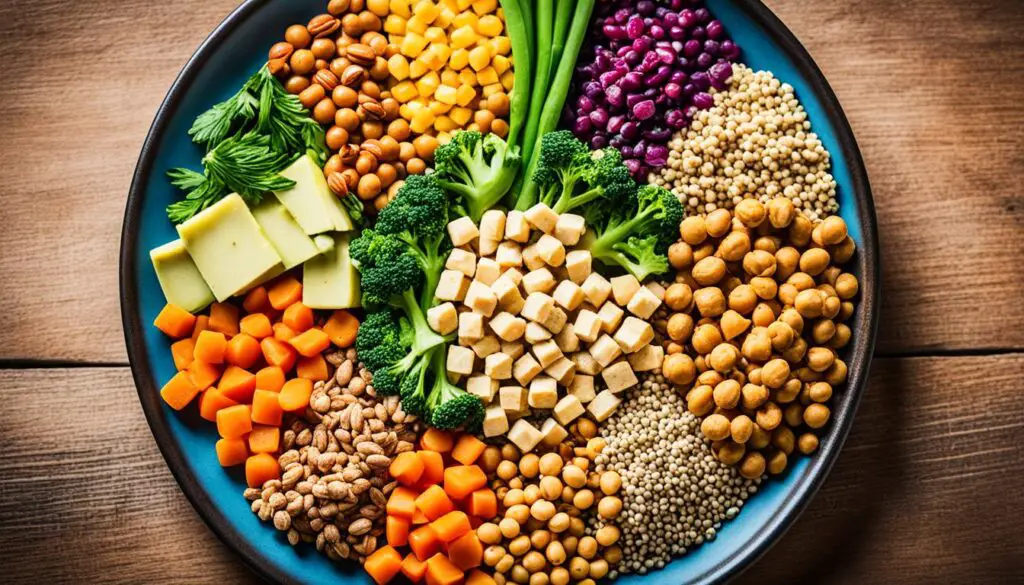
While the traditional HCG diet includes animal protein sources like lean meats, the vegetarian version of the HCG diet focuses on plant-based protein sources. Incorporating these protein sources into meals ensures individuals on the vegetarian HCG diet receive adequate nutrition while promoting weight loss.
Some of the best vegetarian protein sources for the HCG diet include:
| Protein Source | Benefits |
|---|---|
| Tofu | High in protein, low in fat, and a good source of amino acids. |
| Tempeh | Packed with protein, fiber, and beneficial nutrients. |
| Seitan | A gluten-based protein source that is low in fat and carbs. |
| Legumes (lentils, chickpeas, black beans) | Rich in protein, fiber, and essential nutrients. |
| Quinoa | A complete protein source that is gluten-free and packed with nutrients. |
| Greek Yogurt | High in protein, calcium, and probiotics, with low fat and carbs. |
These vegetarian protein sources provide the necessary nutrients while being low in fat and calories, making them suitable for the HCG diet. Including them in meals helps individuals feel satisfied and supports their weight loss efforts.
By utilizing these plant-based protein sources, individuals following the vegetarian HCG weight loss plan can enjoy a variety of delicious and nutritious meals while maximizing their weight loss results.
Vegetarian Meal Ideas for the HCG Diet
Following a vegetarian HCG diet doesn’t have to be boring or repetitive. There are plenty of delicious meal ideas that you can incorporate into your diet plan. By getting creative with your vegetarian meal choices, you can stay motivated and enjoy your weight loss journey on the HCG diet.
Incorporate a Variety of Vegetables
Load up on nutrient-rich vegetables to add flavor, color, and variety to your meals. Here are some ideas:
- Quinoa salads with grilled vegetables
- Tofu stir-fries with lots of colorful veggies
- Lentil soups packed with vegetables
Explore Plant-Based Protein Sources
Vegetarian protein sources play a crucial role in the HCG diet. Try these options:
- Chickpea curries with a mix of spices and vegetables
- Protein-rich Greek yogurt topped with fresh berries
Sample Meal Plan
Here’s a sample day of vegetarian meals on the HCG diet:
| Meal | Recipe |
|---|---|
| Breakfast | Greek yogurt topped with sliced strawberries and a sprinkle of chia seeds |
| Lunch | Quinoa salad with grilled vegetables, like bell peppers, zucchini, and eggplant |
| Snack | A handful of roasted chickpeas |
| Dinner | Tofu stir-fry with broccoli, snap peas, and carrots, seasoned with low-sodium soy sauce and garlic |
| Snack | A cup of lentil soup |
Remember to consult with a healthcare professional before starting the vegetarian HCG diet. By experimenting with different meal ideas, you can create a satisfying and enjoyable weight loss plan tailored to your vegetarian lifestyle.
Incorporating Exercise into the Vegetarian HCG Diet

While exercise is not a requirement on the HCG diet, incorporating physical activity can enhance weight loss results and overall health. For individuals following the vegetarian HCG diet, low-impact exercises like yoga, Pilates, and brisk walking are great options. These exercises help to burn calories, improve cardiovascular health, and increase muscle tone. By including exercise as part of their weight loss strategies, individuals can optimize their vegetarian HCG diet plan and achieve even better results.
Exercise plays a crucial role in any weight loss journey, including the vegetarian HCG diet. Here are some key benefits of incorporating exercise into your weight loss plan:
- Burns Calories: Physical activity increases calorie expenditure, helping you create a calorie deficit for weight loss.
- Improves Cardiovascular Health: Regular exercise strengthens your heart and improves cardiovascular fitness, reducing the risk of heart diseases.
- Increase Muscle Tone: Resistance exercises like yoga and Pilates help build lean muscle mass, giving you a toned and defined physique.
Low-Impact Exercises for the Vegetarian HCG Diet
When it comes to exercise on the vegetarian HCG diet, low-impact workouts are highly recommended. They are gentle on the joints while providing numerous health benefits. Here are some low-impact exercises suitable for individuals following the vegetarian HCG diet:
- Yoga: Practicing yoga not only improves flexibility and balance but also helps reduce stress and improve overall well-being. As a low-impact exercise, it is ideal for those on the HCG diet.
- Pilates: Pilates focuses on core strength, stability, and flexibility. It helps tone muscles, improve posture, and increase body awareness. Pilates is also gentle on the joints, making it suitable for the vegetarian HCG diet.
- Brisk Walking: Walking is a simple and effective low-impact exercise that can be easily incorporated into your daily routine. It helps burn calories, strengthen the lower body, and improve cardiovascular health.
Remember to consult with your healthcare provider before starting any exercise program, especially if you have any pre-existing medical conditions.
By including exercise in your vegetarian HCG weight loss strategies, you can boost your metabolism, enhance your weight loss results, and improve your overall well-being.
Hydration and its Impact on Weight Loss
Staying hydrated is crucial for overall health and can significantly support weight loss efforts on the vegetarian HCG diet. Adequate hydration not only helps to flush out toxins but also supports digestion and maintains proper bodily functions. When following the vegetarian HCG diet, it is essential to prioritize drinking plenty of water throughout the day.
“Water is the elixir of life and a powerful tool for weight loss.”
Drinking enough water can have multiple benefits for weight loss. Firstly, it can help curb cravings and reduce the likelihood of overeating. Often, thirst can be mistaken for hunger, leading individuals to consume unnecessary calories. A simple sip of water can help distinguish between true hunger and mere thirst.
Moreover, drinking water promotes a feeling of fullness, which can prevent overeating by reducing appetite. By staying adequately hydrated, individuals can better manage portion sizes and maintain control over their food intake.
Additionally, water is calorie-free and can be a better alternative to high-calorie beverages such as sugary sodas or sweetened juices. By replacing these calorie-dense drinks with water, individuals on the vegetarian HCG diet can reduce their overall calorie intake, leading to more effective weight loss.
Finally, staying hydrated supports the body’s natural ability to burn fat. When dehydrated, the body’s metabolism can slow down, making it more challenging to lose weight. Drinking enough water helps maintain optimum metabolic function, ensuring that the body efficiently burns calories and promotes fat loss.
To optimize weight loss results on the vegetarian HCG diet, it is recommended to drink at least 8 cups (64 ounces) of water per day. However, individual needs may vary depending on factors such as body weight, activity level, and climate. It is essential to listen to your body and drink water whenever you feel thirsty.
Tips for Staying Hydrated on the HCG Diet:
- Carry a water bottle with you at all times to ensure easy access to water throughout the day.
- Set reminders or use smartphone apps to prompt you to drink water regularly.
- Sip water before each meal to help control portion sizes and reduce calorie intake.
- Add flavor to your water with natural ingredients like cucumber, lemon, or mint to make it more enjoyable.
By making hydration a priority and following these tips, individuals on the vegetarian HCG diet can optimize their weight loss results and improve their overall health.
Managing Hunger and Cravings on the Vegetarian HCG Diet
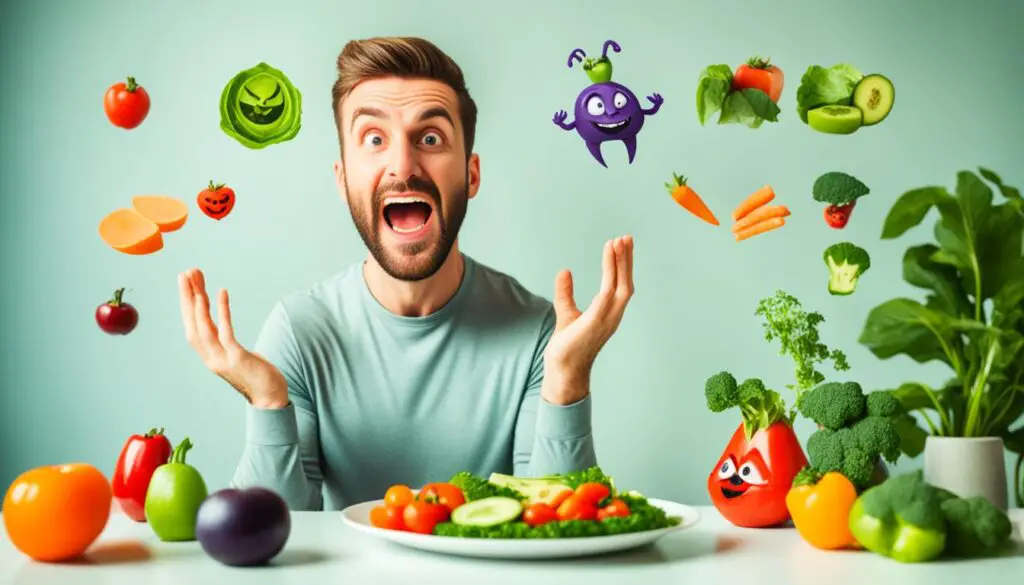
Hunger and cravings can be challenging to manage while on a weight loss program, such as the vegetarian HCG diet. However, with proper strategies in place, individuals can overcome these obstacles and achieve success in their weight loss journey.
1. Eat Small, Frequent Meals
One effective way to combat hunger on the vegetarian HCG diet is to eat small, frequent meals throughout the day. This approach helps to keep blood sugar levels stable and prevents extreme hunger that can lead to overeating. It’s important to focus on consuming meals that are nutrient-dense and balanced, incorporating a variety of vegetables, whole grains, and vegetarian protein sources.
2. Choose High-Fiber Foods
High-fiber foods play a crucial role in managing hunger and promoting a feeling of fullness. Incorporating foods like fruits, vegetables, whole grains, and legumes into meals can help individuals stay satisfied for longer periods. These foods take longer to digest, keeping hunger at bay and reducing the likelihood of cravings.
3. Pay Attention to Hunger Cues
Listening to the body’s hunger cues is essential when managing hunger on the vegetarian HCG diet. It’s important to distinguish between true physical hunger and emotional or psychological cravings. When genuinely hungry, nourishing the body with a balanced meal is necessary. However, if cravings arise without a physical need for food, it’s important to find healthy alternatives to satisfy the taste buds without sabotaging weight loss efforts.
Quote: “By listening to my body’s hunger cues and responding with nutritious meals, I was able to effectively manage hunger and stay on track with my weight loss goals.” – Jane Smith, vegetarian HCG diet participant
4. Find Healthy Alternatives for Cravings
Cravings can often derail weight loss efforts, but finding healthy alternatives can help satisfy cravings without compromising progress. For example, swapping sugary snacks for fresh fruit, opting for air-popped popcorn instead of chips, or enjoying a square of dark chocolate can provide the desired taste without derailing the vegetarian HCG diet.
5. Stay Hydrated
Proper hydration is often overlooked but plays a significant role in managing hunger and cravings. Drinking an adequate amount of water throughout the day can help curb cravings and promote a feeling of fullness. It’s recommended to drink water before meals to help create a sense of satiety and prevent overeating.
6. Practice Mindful Eating
Mindful eating involves being present and fully engaged in the act of eating. By slowing down and savoring each bite, individuals can enhance their appreciation for food and become more attuned to their body’s signals of fullness. Taking the time to chew slowly, savor the flavors, and truly enjoy each meal can help manage hunger and prevent overeating.
7. Keep a Food Journal
Keeping a food journal can be a helpful tool in managing hunger and cravings on the vegetarian HCG diet. By tracking meals, snacks, and emotions related to eating, individuals can identify patterns and triggers that may contribute to overeating or emotional eating. This awareness can facilitate better decision-making and help individuals stay on track with their weight loss goals.
By implementing these strategies to manage hunger and combat cravings, individuals can achieve success on the vegetarian HCG diet. Remember, each person’s experience may vary, so it’s important to listen to your body and make adjustments accordingly.
Monitoring Progress and Adjusting the Vegetarian HCG Diet

Tracking your progress is a crucial aspect of achieving successful weight loss on the vegetarian HCG diet. By monitoring your weight regularly and documenting your measurements and body composition changes, you can gain valuable insights into your progress. Keeping a tracking chart can assist in identifying any plateaus or trends in your weight loss journey. This allows you to make informed decisions and necessary adjustments to optimize your results on the vegetarian HCG diet.
To track your progress effectively, here are some steps you can take:
- Weigh yourself regularly: Use a reliable scale to track your weight at consistent intervals, such as once a week or every two weeks. Record your weight in a journal or use a spreadsheet to visualize your progress over time.
- Measure your body: Alongside weight, take measurements of your waist, hips, thighs, and other problem areas. This will help you track changes in body composition and identify improvements beyond just weight loss.
- Use a tracking chart: Consider creating a visual chart to track your measurements and weight loss progress. Displaying your journey in this way can help you stay motivated and provide a clear representation of your accomplishments.
If you experience stalled weight loss or slower progress, don’t be discouraged. Here are some adjustments you can make to boost your results:
- Increase water intake: Proper hydration is essential for weight loss. Aim to drink at least 8-10 glasses of water per day to support your body’s natural cleansing processes and enhance your metabolism.
- Modify meal choices: Assess your daily food intake and look for areas where you can make healthier choices. Ensure your meals are balanced, filled with nutrient-dense ingredients, and aligned with the vegetarian HCG diet guidelines.
- Add light exercise: Incorporating light exercises like walking, yoga, or swimming can help rev up your metabolism and accelerate weight loss. Start with low-impact activities and gradually increase intensity as your fitness level improves.
By monitoring your progress consistently and making adjustments when necessary, you can stay on track and achieve your weight loss goals on the vegetarian HCG diet. Remember, each individual’s journey is unique, so it’s important to listen to your body and tailor the diet to your specific needs.
| Tracking Tips | Benefits |
|---|---|
| Regularly weigh yourself | Track weight loss progress and adjust diet accordingly |
| Measure body composition | Monitor changes beyond weight loss |
| Use a tracking chart | Visualize progress and stay motivated |
Remember, weight loss is a journey, and progress may fluctuate. Stay committed, stay positive, and stay focused on your goals. With perseverance and regular monitoring, you can achieve remarkable vegetarian HCG weight loss results and attain the healthier, happier lifestyle you desire.
Maintaining Weight Loss After the Vegetarian HCG Diet

After completing the vegetarian HCG diet, it’s crucial to ensure long-term success by transitioning into a maintenance phase. This phase is designed to prevent weight regain and sustain the achieved weight loss. By following a structured maintenance plan and adopting healthy lifestyle habits, individuals can maintain their weight loss results for the long term.
During the maintenance phase, individuals gradually increase their calorie intake while continuing to avoid foods high in sugar and starch. This gradual increase allows the body to adjust to a higher calorie intake without triggering significant weight gain. It’s important to remain mindful of portion sizes and make conscious decisions to include nutrient-dense foods in the diet.
To maintain weight loss after the vegetarian HCG diet, it’s essential to continue making healthy food choices. Focus on incorporating whole, unprocessed foods such as fruits, vegetables, whole grains, and lean proteins into your daily meals. These foods provide essential nutrients while keeping calorie intake in check. Consider meal prepping and planning ahead to ensure you have nutritious options readily available.
In addition to maintaining a healthy diet, regular exercise is key for long-term success on the HCG diet. Incorporate a variety of physical activities that you enjoy, such as cardio exercises, strength training, or yoga. Aim for at least 150 minutes of moderate-intensity exercise or 75 minutes of vigorous-intensity exercise per week, according to the recommendations of the American Heart Association.
By following a maintenance plan and adopting healthy lifestyle habits, individuals can optimize weight loss maintenance and enjoy the long-term success of the vegetarian HCG diet. It’s important to remember that weight loss is a journey, and consistency is key. Focus on making sustainable changes that you can maintain for a lifetime.
Key Takeaways:
- Transition into a maintenance phase after completing the vegetarian HCG diet to prevent weight regain.
- Gradually increase calorie intake while avoiding sugar and starch.
- Continue making healthy food choices and incorporating regular exercise into your daily routine.
- Focus on whole, unprocessed foods and portion control to maintain weight loss.
- Design a personalized maintenance plan and adopt healthy lifestyle habits for long-term success.
Conclusion
In conclusion, the vegetarian HCG diet provides a tailored and effective approach to weight loss for individuals following a vegetarian or vegan lifestyle. By adhering to the specific guidelines of the vegetarian HCG diet plan and implementing strategies to maximize weight loss, individuals can achieve their desired results. However, it is crucial to remember that the vegetarian HCG diet is a short-term program and should be followed under the guidance of a healthcare professional.
With dedication and commitment, individuals can experience significant weight loss and improve their overall health on the vegetarian HCG diet. By incorporating plant-based protein sources, following delicious meal ideas, engaging in low-impact exercises, staying hydrated, managing hunger and cravings, and monitoring progress, individuals can optimize their weight loss journey on the vegetarian HCG diet.
It is important to note that after completing the vegetarian HCG diet, individuals should transition into a maintenance phase to prevent weight regain. By adopting healthy lifestyle habits, making mindful food choices, and incorporating regular exercise, individuals can maintain their weight loss results and enjoy long-term success. Remember, always consult with a healthcare professional before starting any weight loss program or making significant dietary changes.
FAQ
What is the vegetarian HCG diet?
The vegetarian HCG diet is a modified version of the traditional HCG diet, tailored for individuals following a vegetarian or vegan lifestyle. It includes plant-based protein sources and excludes animal products.
How does the vegetarian HCG diet work?
The vegetarian HCG diet combines an ultra-low calorie diet with the use of the hormone HCG to promote weight loss. By following a specific diet plan and making smart food choices, individuals can maximize their weight loss results.
What are the phases of the HCG diet?
The phases of the HCG diet include the loading phase, the fat burn phase, the maintenance phase, and the long-term maintenance phase. Each phase has specific guidelines for calorie intake, food choices, and the use of HCG hormone.
What are some vegetarian protein sources on the HCG diet?
Vegetarian protein sources on the HCG diet include tofu, tempeh, seitan, legumes (such as lentils, chickpeas, and black beans), quinoa, and Greek yogurt. These options are low in fat and calories, making them suitable for the vegetarian HCG diet.
Are there any meal ideas for the vegetarian HCG diet?
Yes, some vegetarian meal ideas for the HCG diet include quinoa salads with grilled vegetables, tofu stir-fries with lots of colorful veggies, lentil soups, chickpea curries, and Greek yogurt with fresh berries. These meals provide a balance of protein, fiber, and healthy carbohydrates while keeping the calorie count low.
Should I exercise while on the vegetarian HCG diet?
While exercise is not a requirement on the HCG diet, incorporating physical activity can enhance weight loss results and overall health. Low-impact exercises like yoga, Pilates, and brisk walking are great options for individuals following the vegetarian HCG diet.
How important is hydration on the vegetarian HCG diet?
Staying hydrated is essential for overall health and can also support weight loss efforts. It’s important to drink plenty of water throughout the day while on the vegetarian HCG diet. Adequate hydration helps to flush out toxins, support digestion, and maintain proper bodily functions.
How can I manage hunger and cravings on the vegetarian HCG diet?
To combat hunger, individuals can eat small, frequent meals throughout the day and focus on high-fiber foods that provide a feeling of fullness. To combat cravings, individuals can find healthy alternatives that satisfy their taste buds without derailing their weight loss efforts.
How should I monitor my progress on the vegetarian HCG diet?
Monitoring progress is crucial for successful weight loss on the vegetarian HCG diet. Individuals can track their weight regularly, document their measurements and body composition changes, and use a tracking chart to note any plateaus or trends in weight loss. Adjustments can be made if weight loss stalls or becomes slower.
What should I do after completing the vegetarian HCG diet?
After completing the vegetarian HCG diet, it’s important to transition into a maintenance phase to prevent weight regain. This phase involves gradually increasing calorie intake while avoiding sugar and starch. It’s also important to continue making healthy food choices and incorporating regular exercise into the daily routine.

